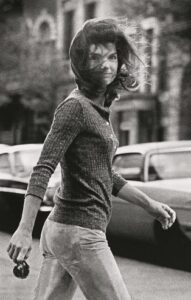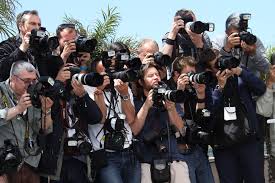“Once you’re a celebrity, always a celebrity. You have to face it. You’re a celebrity, you’re fair game in public areas.” – Ron Galella
Celebrities are perfect. At least, this is the intent of various PR teams and studios. A celebrity must maintain an unattainable level of beauty and perfection, whether it is their lifestyle or their physical self. It’s hard work that many people spend their livelihoods maintaining. What if there was a method to strip it all away?
It’s relatively simple, actually. After all, Ron Galella built a career out of borderline criminal photography, and he’s honored for deconstructing celebrities’ lives in his invasive photographs.
To clarify, Ron Galella is a well-known paparazzo who is best known for his work “Windblown Jackie.” This piece portrays Jacqueline Lee “Jackie” Kennedy Onassis walking down the street with her hair being blown in the wind. It is one of the most famous paparazzi photos in the (unofficial) genre. It’s candid and artfully shot. Ron Galella does have a talent for photography, and he portrays that talent in all his work.

However, this does not change the impacts of his kind of work. Ron Galella hunted celebrities down in the gluttonous way that only humans can do, and he did not relent easily once he found his “muse.” Jackie Onassis was harassed consistently by Ron. Even after a restraining order of 25ft was filed, he used a 25 foot measuring tape to get close to Jackie as a “joke.”

His incidents with Jackie are his most infamous, but he has many more stories about getting the “perfect shot” at everyone’s expense. AnOther Magazine had an interview with Ron Galella, and they discussed his memoir Shooting Stars: The Untold Stories of Ron Galella which references that, “he was spat at and punched by Sean Penn; had his tooth knocked out by Richard Burton’s bodyguard; his tires slashed by Elvis Presley’s bodyguards; hosed down by Brigitte Bardot’s security; banned from Studio 54, twice; and caused Elizabeth Taylor to hiss, ‘I’m going to kill Ron Galella!’” and many other various “honors.”
The behavior of Ron Galella and various other paparazzi is perfectly insane. It reflects a dehumanization of celebrities that’s strangely commonplace within our culture, and it perpetuates this narrative in every magazine, art gallery, and article that displays these photographs. It is a primary contributor to our modern disrespect for privacy paraded around on social media. Not only does this continue to happen to celebrities such as Chappell Roan and Sabrina Carpenter (as of recently), but strangers can be caught in the crossfire of influencer videos and harassed all the same.
The act of paparazzi teeters the line of the law very precariously. Many anti paparazzi legislation has been instated due to the gross disrespect of privacy that comes with the profession, but this isn’t a strong enough deterrent for some. The crime of the art does seem to be the cognitive dissonance required to justify its invasive nature. Photographers like Ron Galella believe that they are doing the celebrities a favor by publicizing “authentic beauty.” The justification of these actions ultimately leads to the normalization of stalking and the denial of privacy to citizens, no matter their social status.
Despite the horrors of harassment, there is a certain allure to paparazzi photography that cannot be overlooked. These photographers excel in portraying the “everyday lives” of these celebrities. Audiences are desperate for authenticity, and publications will pay ridiculous amounts to get it. Our appetite for more is never satiated because we seem to have an endless hunger for knowledge. This type of art feeds on “knowing the unknowable” and “discovering the mystery” of a person out of our reach.
However, a celebrity is not a person, but a persona. Once the persona is separated from the stage it was built for, the celebrity (figuratively) ceases to exist. Paparazzi are meant to skirt the line. To give an audience a taste of a celebrity’s inner life and personhood. However, if the photographer reveals too much, the illusion of perfection and mystery is broken. An audience grows bored once all that is left to reveal is the mundane, yet the paparazzi will continue to rip and tear at the persona to get to the person until the celebrity is thoroughly thwarted. The art of paparazzi is the desecration of the persona, and the destruction of the person.







What an interesting analysis on paparazzi culture that is super relevant today. I particularly enjoyed your very last statement about the “desecration of the persona, and the destruction of the person”. I think this echoes so loudly in our modern society. It’s almost as if not just paparazzi nowadays, but most people do not view celebrities as real people, we often dissect their lives much farther than we would with anyone else, simply because they are in the spotlight. I think there is a myth that we have become less critical of celebrities in the past 10 years, maybe because there are less articles about body image, but I think that couldn’t be farther from the truth. A lot of the destruction now doesn’t just come from the paparazzi and the magazines, it’s from everyone on social media who view their idols with such harsh lenses.
Zoe,
To begin, I loved how you incorporated pictures, videos and other forms of media into your post. It made your article interactive and engaging. Additionally, I felt this post does a strong job of breaking down the darker side of paparazzi culture, with Ron Galella as a clear example of how the line between art and harassment is often crossed. I like how you acknowledge his photographic talent while also emphasizing the harm he caused, especially through his pursuit of Jackie Kennedy, even after legal measures were taken. The way you connect his behavior to the broader cultural obsession with authenticity makes the analysis feel very relevant, since the same appetite for unfiltered celebrity moments still exists today.
This article is very well done! Great introductory quote and hook. Kept me engaged the whole time! I’ve never heard of Ron Galella, so this was thoroughly interesting to read. I’ve often heard about the intrusive nature of the paparazzi and the age-old fued between these photographers and celebrities. Galella’s perspective, that he’s showcasing the authentic lives of celebrities, seems at first to be a noble cause. But, as you’ve said, that requires crossing many boundaries to delve into the personal lives of celebrities, who are surrounded by professionals curating their public image. It raises the question: where does the line truly lie? I’m honestly not sure. Overall, a very interesting and controversial topic that I enjoyed reading about. Great use of imagery as well.
Hey Zoe! This is an interesting topic to focus on. I had never heard of Ron Galella, but I have heard about many other paparazzi horror stories. I am always disgusted when I see Daily Mail– or other various celebrity-focused platforms– post celebrity paparazzi photos of usually women enjoying a beach day or vacation, and an entire story is made up about how they are gaining weight, or look horrible. The stories never have anything to do with their work, companies, successes, etc., and only ever focus on their appearance. I can’t imagine someone following me around and taking photos of me only to post criticisms about my appearance. It almost strips away everything the celebrity has worked for and views them only as an object that has to look pretty. It also brings into question safety. I always see videos of paparazzi going to extreme lengths for photos of celebrities, essentially putting everyone involved and bystanders in danger. I really don’t understand how there hasn’t been some form of regulation on paparazzi.
This article brings up a lot of good points and highlights issues that we are still struggling with as a society today. At red carpets for example, I see videos of paparazzis lining the barricade, yelling at the celebrity to pose a certain way or to look at them and “smile”, almost painting a picture of a zoo animal being photographed by onlookers. Even with the rise of social media influencers, paparazzis have found a way to wiggle themselves into their lives – following them to restaurants, videotaping them, and asking them intrusive questions. In many of these, the influencers don’t even answer the questions, but somehow the way they “looked at the camera” creates a headline. It creates this weird dynamic of life not being private online, and now in person. I think it’s also tricky to discuss this because it is these peoples careers, so evidently they will never give it up. It does shine a light on how warped our society has become with the rise of social media though.
Your article raises a compelling point about the paparazzi’s role in both feeding and dismantling celebrity culture. Ron Galella’s work, while undeniably artistic at times, shows how the pursuit of “authenticity” often comes at the cost of human decency. The idea that celebrities are “fair game” blurs the line between art and exploitation. It’s honestly quite unsettling, how our endless hunger for “realness” can drive such harmful practices.
Hey Zoe! Your discussion of paparazzi does an excellent job of dissecting both sides of the issue, presenting not just the problems that it creates but the broader issues that make it possible. It would be easy to point fingers at Ron Galella as a stalker but you take on the challenge of providing a more nuanced view, digging deeper until you found how we are all responsible for the destruction of celebrities as well as their creation.